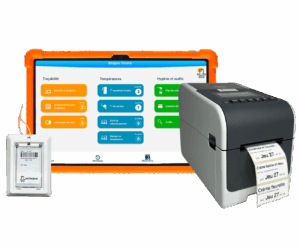HACCP standards: Everything you need to know about hygiene rules
Summary
- HACCP standard: the principles of food hygiene in catering
- Why implement HACCP hygiene standards?
- The principles of the HACCP standard
- The structures concerned by HACCP standards
- Your business compliant with HACCP regulations with Octopus HACCP
- HACCP, ISO 22000 standard, Hygiene Package, EC regulation 852/2004, what are the differences?
HACCP Standard: Principles of Food Hygiene in Catering
All about HACCP standards: Food hygiene is an essential principle in all activities related to the agri-food sector. Whether you are involved in commercial, collective, fast food, takeaway catering, or work as a caterer. Additionally, you should know that your activity is regulated by the Hygiene Package, a set of European regulations applicable since January 1st 2006. These define the responsibilities of professionals in the sector, from primary production (animal and plant) to final consumer distribution. Furthermore, they require the implementation of procedures based on the HACCP standard (Hazard Analysis Critical Control Point). Here’s everything you need to know about HACCP standards and how to apply them daily.
Why Implement HACCP Hygiene Standards?
HACCP hygiene standards were created in the 1960s. Their implementation addresses the need for food safety. They help detect any anomaly along the journey of food “from farm to fork,” and control the risks of collective foodborne illness outbreaks (TIAC). Generally, HACCP standards form a system for hazard analysis. Additionally, traceability is based on both the Good Hygiene Practices (GHP) and Good Manufacturing Practices (GMP) guides.
Another good reason to deploy the HACCP standard is set out in Article 5 of the European Hygiene Package regulation. This article requires professionals in the agri-food sector to establish self-monitoring procedures and manage food safety risks at every stage of food handling.
The Principles of the HACCP Standard
The HACCP standard includes 7 principles:
- Hazard and risk analysis;
- Identification of Critical Control Points (CCPs) requiring monitoring;
- Definition of acceptable critical limits;
- Establishment of self-monitoring procedures;
- Definition of corrective action plans in case of non-conformity detection;
- Control of the effectiveness of corrective measures;
- Implementation of a documentation system to ensure product traceability at every stage (receiving, storage, cold room temperature tracking, monitoring of expiration dates, etc.).
Moreover, professionals required to apply the HACCP standard follow 12 steps that provide a roadmap to establish procedures tailored to their activity. These 12 steps incorporate all HACCP principles and guide professionals in setting up a HACCP-friendly system for monitoring and assessing food risks. They enable the creation of a vigilance system adapted to each profession and organization.
Structures Concerned by HACCP Standards
Which Activities Are Subject to the HACCP Standard?
The HACCP standard defines the safest framework for meeting the result-based obligations required of all actors in the agri-food sector. The main structures concerned by the HACCP standard are:
- Food producers;
- Commercial, traditional, fast food, takeaway catering, and catering services;
- Collective catering for schools, retirement homes, businesses;
- Market gardeners, butcher shops, fishmongers;
- Companies specializing in food transportation, storage, logistics, and distribution;
- Cleaning companies specialized in the agri-food industry.
In general, the HACCP standard applies to all structures that handle food products. However, some activities are exempt from the HACCP standard, such as guesthouses, bakeries, and supermarket deli counters. Still, food safety for consumers is a priority. It is essential to be inspired by HACCP principles to avoid TIAC risks.
Make Your Activity Compliant with HACCP Regulations Using Octopus HACCP
The Octopus HACCP application simplifies the implementation of the HACCP standard for monitoring and managing food safety risks in your organization. It is a simple and efficient digital application developed based on the HACCP method. Moreover, it is customizable for each type of activity (collective catering, food trades, etc.) and offers intuitive features, easily accessible and suited for mobile or tablet data entry. Additionally, it allows for simple traceability and history management of products, secure temperature readings, delivery tracking, and cleaning schedule management.
HACCP, ISO 22000, Hygiene Package, EC Regulation 852/2004 – What’s the Difference?
Food safety is a critical and complex issue. To support the diversity of the agri-food sector, numerous reference texts aim to ensure safety at every link of the chain:
- EC Regulation 852/2004: This sets general rules on food hygiene for food business operators. It covers all stages of food production, processing, and distribution, including exports. Article 5 of this EU regulation requires food operators to establish, apply, and maintain one or more permanent procedures based on HACCP principles.
- The Hygiene Package: In force since January 1st 2006, it applies to the entire agri-food chain in all EU member states. It includes Regulations (EC) No 178/2002, 852/2004, 853/2004, 183/2005, and EU 2017/625. This framework is complemented by various implementing regulations. Notably, these regulations set hygiene objectives but do not mandate the methods for achieving them.
- ISO 22000: This is a voluntary international standard for food safety management. It outlines what an agri-food organization must implement to demonstrate its ability to control food safety risks. It is a global reference. Its value lies in standardizing terminology across food sectors and countries. It has also provided a universal definition of HACCP principles and clarified the meaning of the Operational Prerequisite Program (OPRP).
The difference between these standards lies in their mandatory or voluntary nature and their scale. The HACCP standard was made mandatory in Europe in 2006 with the Hygiene Package. ISO 22000 is voluntary and international. However, HACCP is universally recognized by all.



